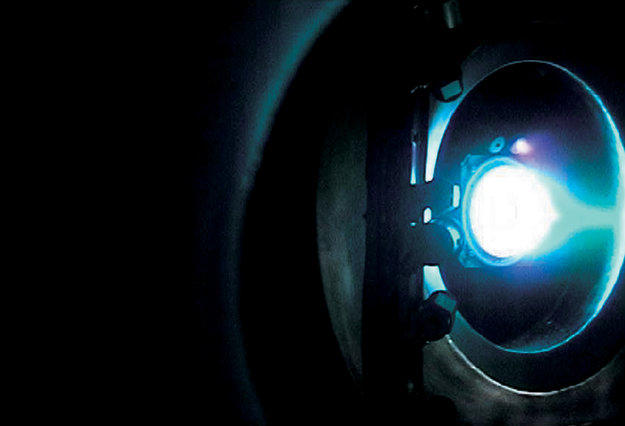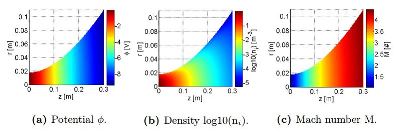Advanced Plasma Diagnostics

Electric propulsion (EP) produces thrust by ionizing and accelerating atoms to very high velocities. Although the total mass flow of the ejected ions is far lower than what is obtained in chemical propulsion, the total thrust is the product of mass flow and exit velocity. EP thrusters that can deliver up to several Newton of thrust due to their very high specific impulse.
Many types of EP systems exist, but unfortunately the physics behind their operation is not very well known. In particular, measurements of the exit plume are difficult considering the low density, high temperature plasma complicates direct measurements. A well-known technique for measurement of velocities is Doppler spectroscopy. Light emitted from ions in the plume will be shifted depending on their relative velocity compared to the observer. By measuring the emission spectrum of the plume an estimate can be made on the average velocity. This reveals a significant drawback of this passive technique, it is non-local as all the light is summed together and the spatial information of the velocity within the plume is lost.
The above problem can be solved with two different methods. First, by locally inducing a resonance emission in the plume, the emission wavelength can be shifted. This will localize the emission to the intersection of the incident laser and the line-of-sight. This technique is called Laser Induced Fluorescence and it a complex and therefore time consuming technique. An alternative method, which was explored in short study at the ACT, involves the use of multiple intersecting lines-of-sight. By measuring the emission profile from multiple angles, the local emission profile can be extracted by reformulating the plume as an inverse problem using vector tomography.

Using an analytical model of the plume emission with a varying 3-dimensional velocity profile, the emission spectrum for multiple cameras was calculated. These images were then interpreted using various inversion technique algorithms to determine whether the velocity profile could be reconstructed. Depending on the amount of lines-of-sight and the coverage, both the ion density and velocity profile can be reconstructed to a certain level of accuracy. As expected, providing a-priori profile knowledge is beneficial, especially as the plume density profile decreases rapidly with distance. By providing independent density measurements, the requirement for the number of viewing lines can be further reduced. Overall, achieving a satisfactory reconstruction accuracy could be achieved with 50-100 lines-of-sight from two separate viewing locations.
Literature
- A.L. Balandin and Y. Ono "Tomographic determination of plasma velocity with the use of ion Doppler spectroscopy", European Phys. J. D, 17, 3, 337-344, 2001 (link)
- D. Gawron, S. Mazouffre and C. Boniface "Parametric study of the acceleration layer in a high power Hall effect thruster by Fabry-Pérot spectroscopy", IEPS-2005-144, 2005 (link)